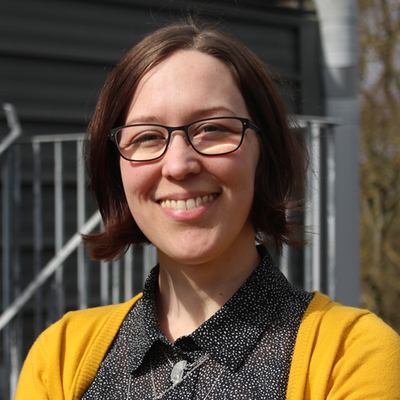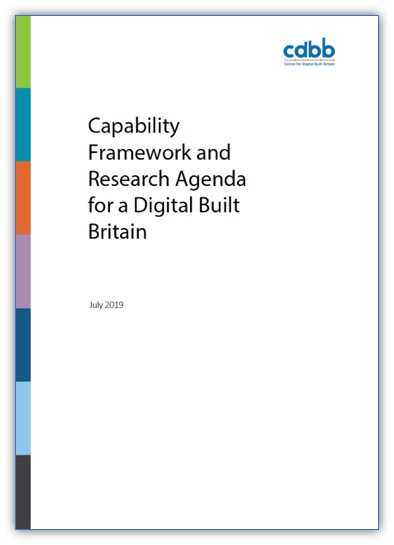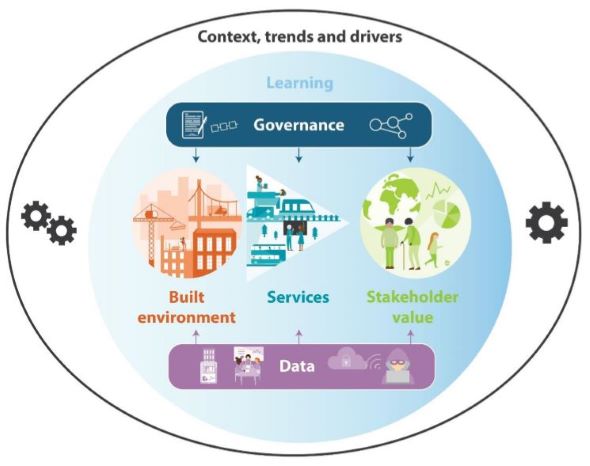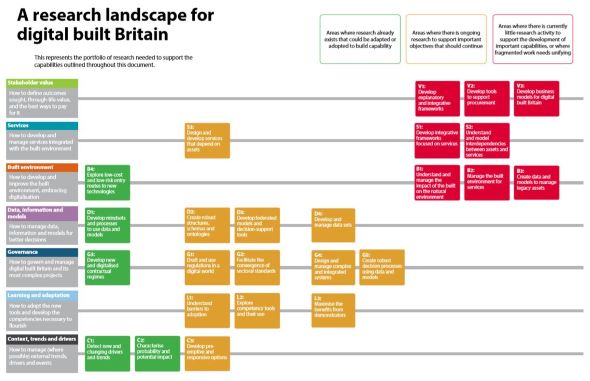
Submitted by Debra Royal on Mon, 12/08/2019 - 13:53
Following the publication of the ‘Capability Framework and Research Agenda for a Digital Built Britain’, CDBB’s Information Specialist Kirsten Lamb reflects on the two years she has helped with exploring and researching the knowledge, skills and capabilities needed for a digital built Britain. Aside from the technical challenges that have been identified, the work has revealed the need for the UK to define what we want our digital future to look like and what we, as citizens, value the most. CDBB is excited to be a part of this and - using Kirsten’s terminology – in being one of the organisations helping with providing course corrections to help steer us towards a positive digitally transformed built and natural environment.
The Capability Framework and Research Agenda recently released by CDBB is the culmination of roughly two years of work from over 90 researchers in six research networks, four consultancy studies and a series of workshops, all to engage with a wide community of participants from across the UK. These groups were asked in various ways to discuss and explore what new knowledge, skills or capabilities the UK would need in order to bring about a digital built Britain. This process brought up a vast number of insights that we at CDBB then had the challenge of combining into the Capability Framework and Research Agenda. This document and its summary provide a clear message about the research needed to develop these capabilities across academia, government and industry: that while there are technical challenges to overcome, the pressing need is to identify what value – for businesses, citizens and the country as a whole – looks like in a more digital future.
In Data for the Public Good, the National Infrastructure Commission points to a host of benefits to gathering and sharing data in and about the built environment, from energy efficiency and less traffic congestion to better performance of infrastructure over its lifetime, leading to financial savings and less environmental impact. But these benefits aren’t the automatic result of fitting sensors to built assets or sharing data between the organisations that build and run them. Creating a digital model of a city does not on its own suddenly reduce the homeless population or make buildings more accessible. Data, modelling and digital technologies are just tools, and we need to know what result we want in order to choose the right tools for the job.
That’s why the Capability Framework and Research Agenda doesn’t just talk about buildings, infrastructure and digitalisation. The value of a digital built Britain for people in the UK – whatever outcomes, metrics or performance indicators are chosen to signal it – comes to them through the services enabled by the built environment, such as housing, transportation, energy, health care and education. In digital built Britain, this core pathway to stakeholder value is underpinned by secure, shared and interoperable data, information and models, and is scaffolded by governance; the laws of the land, standards and frameworks that help set the direction and methods for achieving the outcomes people want. Developing the skills and capabilities to make this system work requires a continuous learning process on the part of individuals, organisations and sectors to develop digital literacy and ensure the right skills are available. Finally, it is crucial to remember the ways in which the drivers, trends and events in the surrounding context – whether foreseen or not – will change the demands on the built environment. (These interrelated categories are shown in Fig. 1.) Using better data, information and models to make sense of these complex interdependencies will help decision-makers deliver better outcomes from the built environment and its dependent services. (See the Smart Infrastructure Paper for an exploration of this process.)
Figure 1: To achieve stakeholder value in digital built Britain, we need to consider multiple interacting facets, each of which is discussed in CDBB’s capability framework.
These are the categories we have used in the Capability Framework and Research Agenda to explore the breadth of capabilities needed in digital built Britain. In some cases, there is already significant work underway to explore these topics, and there are likely to be quick wins available by adopting it (see green boxes in Fig. 2). For many more of the identified research areas, there are active research communities that can support important objectives (see amber boxes in Fig. 2). These communities are close to the real issues and are well positioned to develop new insights and capabilities. This paints a promising picture of a dynamic and active research community working toward a digital built Britain.
Some of the most difficult questions, however, have yet to be fully answered (see red boxes in Fig. 2). For example, there isn’t much investigation yet about managing the built environment in the context of services, managing legacy assets and mitigating the impact of buildings and infrastructure on the climate. Similarly, understanding how services and assets can interrelate and integrate could open up new opportunities in the UK and globally, but we do not fully understand how best to deliver that integration yet. In terms of outcomes, we struggle to adequately describe and measure stakeholder value from the built environment, especially the intangible aspects. We need to find better ways to debate or reach consensus on relevant stakeholders and outcomes and how to use that consensus to specify and procure buildings and services that will deliver value. Finally, we need to develop models that reward those who pay now for assets and services that will create value in the future. For example, if developing and populating a building information modelling (BIM) tool is proven to make a building more sustainable over its entire lifespan and therefore pay for itself, but only after the building has been handed over to occupants, how can we incentivize the people who need to pay for it up front?
Figure 2: An overview of the portfolio of research needed to underpin digital built Britain
The Capability Framework and Research Agenda explores questions like the previous example, each of which is a candidate for future projects. The full report can therefore be used as a tool by research funders, researchers and policymakers to identify how existing research topics link together, find ongoing work in those areas and explore promising avenues for new research. Using the index and hyperlinks throughout the full report will help readers to navigate straight into the detail of their topics of interest. The summary document is a useful starting point that covers the main points for those who just want an overview. We’ve also provided the background resources, including write-ups of the many workshops we held, as a resource for anyone embarking on a research project who wants access to all of the insights generated over the last two years.
In helping to collate the many ideas our experts produced, I came away with the sense that the technical challenges of digitalizing the built environment and services, managing data and information, and modelling complex scenarios are relatively easy to solve. We are missing the capability to build a clearly articulated vision of what we want from digital built Britain that would give some direction to people who are addressing those technical barriers.
Having just marked the 50th anniversary of the first moon landing, I’m reminded of the power of a unifying vision in overcoming huge technical challenges. In his famous speech at Rice University in 1962, President Kennedy set in motion an organising vision that humans would land on the moon within the next seven years. It was an audacious vision that inspired hope for the future and was bigger than the individual innovations of Margaret Hamilton writing the computer code, or Thomas J. Kelly designing the lunar module, or any of the other people involved in designing, building or operating the components of the Apollo 11 mission.
Kennedy spoke about human space exploration as an inevitability. Similarly, digitalisation in the built environment is going to happen whether or not policymakers, citizens or researchers take part in shaping that change. The results might be positive for the UK in general, but without the support and consideration of each of the facets highlighted in the capability framework above, digital built Britain could be less secure, less sustainable, less fair, less inclusive. Fears about a surveillance state, internet platforms monopolizing personal data, a widening digital divide or catastrophic climate change exist as a warning of potential futures we need to work to avoid. A common understanding of the future we are trying to reach would help researchers, policymakers and private sector decision-makers make the small course corrections that send the UK in the chosen direction.
Steering toward a positive future must also be inclusive. After Kennedy’s 1962 speech, American women and people of colour would have to wait two decades to see themselves represented in space; those who might otherwise be left behind in digital built Britain should not have to wait so long to have their voices heard. To stop the digital divide from becoming the next incarnation of income inequality, those who are structurally or socially excluded from digital life should have a voice in how the built environment is digitalised.
In addition to the portfolio of research outlined in Fig. 2, we need a unifying vision of what kind of future we want for the UK. CDBB potentially has a role in the process, but developing a common vision for a digital built Britain that works for everyone will require the input of a wide range of stakeholders beyond the architecture, engineering, construction and operations (AECO) sectors, beyond policymakers, beyond industry. The people of the UK should have a voice in what life will be like in a future where the built assets and services they use are digitally-enabled and where data is ubiquitous throughout. Whether the organising principle is fighting the climate emergency, spreading economic prosperity to all of the regions and people of the UK or something else entirely, we collectively need to articulate a vision of the digital built Britain in which we want to live.



